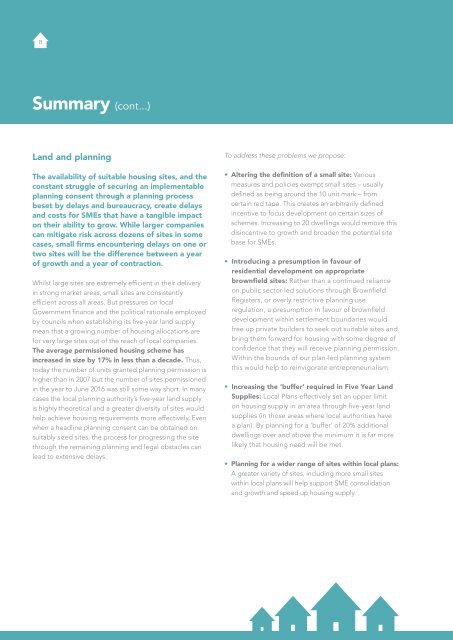Reversing the decline of small housebuilders
HBF_SME_Report_2017_Web
HBF_SME_Report_2017_Web
Create successful ePaper yourself
Turn your PDF publications into a flip-book with our unique Google optimized e-Paper software.
8<br />
Summary (cont...)<br />
Land and planning<br />
The availability <strong>of</strong> suitable housing sites, and <strong>the</strong><br />
constant struggle <strong>of</strong> securing an implementable<br />
planning consent through a planning process<br />
beset by delays and bureaucracy, create delays<br />
and costs for SMEs that have a tangible impact<br />
on <strong>the</strong>ir ability to grow. While larger companies<br />
can mitigate risk across dozens <strong>of</strong> sites in some<br />
cases, <strong>small</strong> firms encountering delays on one or<br />
two sites will be <strong>the</strong> difference between a year<br />
<strong>of</strong> growth and a year <strong>of</strong> contraction.<br />
Whilst large sites are extremely efficient in <strong>the</strong>ir delivery<br />
in strong market areas, <strong>small</strong> sites are consistently<br />
efficient across all areas. But pressures on local<br />
Government finance and <strong>the</strong> political rationale employed<br />
by councils when establishing its five-year land supply<br />
mean that a growing number <strong>of</strong> housing allocations are<br />
for very large sites out <strong>of</strong> <strong>the</strong> reach <strong>of</strong> local companies.<br />
The average permissioned housing scheme has<br />
increased in size by 17% in less than a decade. Thus,<br />
today <strong>the</strong> number <strong>of</strong> units granted planning permission is<br />
higher than in 2007 but <strong>the</strong> number <strong>of</strong> sites permissioned<br />
in <strong>the</strong> year to June 2016 was still some way short. In many<br />
cases <strong>the</strong> local planning authority’s five-year land supply<br />
is highly <strong>the</strong>oretical and a greater diversity <strong>of</strong> sites would<br />
help achieve housing requirements more effectively. Even<br />
when a headline planning consent can be obtained on<br />
suitably sized sites, <strong>the</strong> process for progressing <strong>the</strong> site<br />
through <strong>the</strong> remaining planning and legal obstacles can<br />
lead to extensive delays.<br />
To address <strong>the</strong>se problems we propose:<br />
• Altering <strong>the</strong> definition <strong>of</strong> a <strong>small</strong> site: Various<br />
measures and policies exempt <strong>small</strong> sites – usually<br />
defined as being around <strong>the</strong> 10 unit mark – from<br />
certain red tape. This creates an arbitrarily defined<br />
incentive to focus development on certain sizes <strong>of</strong><br />
schemes. Increasing to 20 dwellings would remove this<br />
disincentive to growth and broaden <strong>the</strong> potential site<br />
base for SMEs.<br />
• Introducing a presumption in favour <strong>of</strong><br />
residential development on appropriate<br />
brownfield sites: Ra<strong>the</strong>r than a continued reliance<br />
on public sector-led solutions through Brownfield<br />
Registers, or overly restrictive planning use<br />
regulation, a presumption in favour <strong>of</strong> brownfield<br />
development within settlement boundaries would<br />
free up private builders to seek out suitable sites and<br />
bring <strong>the</strong>m forward for housing with some degree <strong>of</strong><br />
confidence that <strong>the</strong>y will receive planning permission.<br />
Within <strong>the</strong> bounds <strong>of</strong> our plan-led planning system<br />
this would help to reinvigorate entrepreneurialism.<br />
• Increasing <strong>the</strong> ‘buffer’ required in Five Year Land<br />
Supplies: Local Plans effectively set an upper limit<br />
on housing supply in an area through five-year land<br />
supplies (in those areas where local authorities have<br />
a plan). By planning for a ‘buffer’ <strong>of</strong> 20% additional<br />
dwellings over and above <strong>the</strong> minimum it is far more<br />
likely that housing need will be met.<br />
• Planning for a wider range <strong>of</strong> sites within local plans:<br />
A greater variety <strong>of</strong> sites, including more <strong>small</strong> sites<br />
within local plans will help support SME consolidation<br />
and growth and speed up housing supply.


